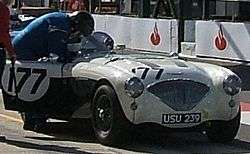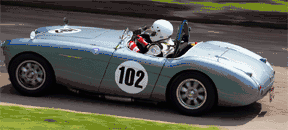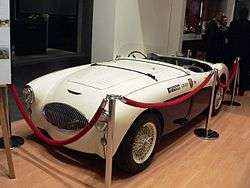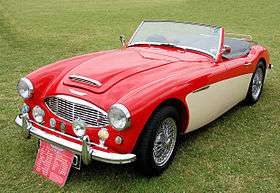Austin-Healey 100
| Austin-Healey 100 | |
|---|---|
|
1956 Austin-Healey 100 | |
| Overview | |
| Production | 1953–1956 |
| Assembly |
Longbridge, England West Bromwich, England |
| Powertrain | |
| Engine | 2660 cc I4 |
| Transmission | 3-speed (series BN1) or 4-speed (series BN2) manual |
| Dimensions | |
| Wheelbase | 90 in (2,286 mm)[1] |
| Length | 151 in (3,835 mm)[1] |
| Width | 60 in (1,524 mm)[1] |
| Height | 49.25 in (1,251 mm)[2] |
| Chronology | |
| Successor | Austin-Healey 100-6 |
The Austin-Healey 100 is a sports car that was by Austin-Healey built from 1953 until 1956.
It was developed by Donald Healey to be produced in-house by his small Healey car company in Warwick and based on Austin A90 Atlantic mechanicals.[1] Healey built a single Healey Hundred for the 1952 London Motor Show, and the design impressed Leonard Lord, managing director of Austin, who was looking for a replacement to the unsuccessful A90. Body styling was by Gerry Coker, the chassis was designed by Barry Bilbie with longitudinal members and cross bracing producing a comparatively stiff structure upon which to mount the body. In order to keep the overall vehicle height low the rear axle was underslung, the chassis frame passing under the rear axle assembly.
Lord struck a deal with Healey to build it in quantity, bodies made by Jensen Motors were given Austin mechanical components at Austin's Longbridge factory. The car was renamed the Austin-Healey 100.
The "100" was named by Healey for the car's ability to reach 100 mph (160 km/h); its successor, the better known Austin-Healey 3000, was named for the 3000 cc displacement of its engine.[3]
Production Austin-Healey 100s were finished at Austin's Longbridge plant alongside the A90 and based on fully trimmed and painted body/chassis units produced by Jensen in West Bromwich—in an arrangement the two companies previously had explored with the Austin A40 Sports. 14,634 Austin-Healey 100s were produced.[4]
The 100 was the first of three models later called the Big Healeys to distinguish them from the much smaller Austin-Healey Sprite. The Big Healeys are often referred to by their three-character model designators rather than by their models, as the model names do not reflect the mechanical differences and similarities well.
BN1
The first 100s (series "BN1") were equipped with the same undersquare 87.3 mm (3.4 in) bore and 111.1 mm (4.4 in) stroke 90 bhp (67 kW) 2660 cc I4 engines and manual transmission as the standard production A90, but the transmission was modified to be a three-speed unit with overdrive on second and top.
Girling 11 in (279.4 mm) drum brakes were fitted all round. The suspension utilised modified Austin A90 components in order to be as cost effective as possible, steering was by Austin's worm and peg system. Front suspension was independent, double wishbone using coil springs and at the rear a rigid axle with semi elliptic leaf springs.
A BN1 tested by The Motor magazine in 1953 had a top speed of 106 mph (171 km/h) and could accelerate from 0–60 mph (97 km/h) in 11.2 seconds. A fuel consumption of 22.5 miles per imperial gallon (12.6 L/100 km; 18.7 mpg‑US) was recorded. The test car cost £1063 including taxes.[5]
A total of 10030 BN1s were built from May 1953 until replaced by the BN2 model in August 1955.[6] A 1954 BN1 (chassis #446766*4) is on permanent display in the Bonneville Salt Flats exhibit at the Simeone Foundation Automotive Museum in Philadelphia, PA, USA.[7]
BN2

The BN2 was fitted with a real four-speed manual transmission, still with overdrive on the top two gears. Other features that distinguish the BN2 from the BN1 are the slightly larger front wheel arches, different rear axle and being the first 100 with optional two-tone paint.
- In 1955, a high-performance 100M model was introduced, with larger carburettors, a cold air box to increase engine air flow, high-lift camshaft and 8.1:1 compression pistons. It produced 110 bhp (82 kW) at 4500 rpm. The front suspension was stiffened and the bonnet gained louvres, along with a bonnet belt. Approximately 70% of 100Ms were finished with a two-tone paint scheme, including one White over Red and another in Black over Pink for display at the 1955 London Motor Show. In all, 640 100Ms were built by the factory.
- The 100M components (including the high compression pistons) were also available as the Le Mans Engine Modification Kit, which could be installed in either a BN1 or BN2 with the engine in situ, improving the power output to approximately 100 bhp (75 kW) at 4500 rpm. The kit could be ordered from BMC, allowing private owners to make their own modifications.[8]
The BN2 was available initially in Carmine Red which was replaced with Reno Red, Spruce Green, Healey Blue, Florida Green, Old English White, Black, and approximately 50 Gunmetal Grey cars. Two-tone options were: White/Black; Reno Red/Black; Healey Blue/White; Black/Reno Red; and Florida Green/White[6]
By January 1956 production was running at 200 cars each month and sales in California 150 cars each month.[9]
The final BN2 was built in July 1956, with a total of 4604 BN2s produced, including the 100M.[6]

Many BN-2 and 100-M Austin Healeys compete in vintage events like the Pittsburgh Vintage Gran Prix.
100S

Built primarily with racing in mind, the aluminium-bodied "100S" (for Sebring) model developed 132 bhp (98 kW) at 4700 rpm. Only 50 production cars were made, plus an additional five works development/special test cars hand built by the Donald Healey Motor Company at Warwick.[10] To minimize weight and improve performance the cast iron cylinder head was replaced by a Weslake designed aluminium one, and the overdrive unit was not installed. Dunlop disc brakes were used all-round, the world's first production car to feature them both front and rear.[11] To further lighten the vehicle, bumpers and hood (convertible top) were eliminated, the grille reduced in size, and the windscreen made of plastic. In all, weight was reduced by approximately 200 lb (91 kg). The majority of 100Ss were two-toned white with Lobelia Blue sides. A handful were produced in solid Spruce Green and red, and a single one in black.[4]
An unrestored works racing team 1953 Austin-Healey '100S' Special Test Car that had been campaigned by factory drivers Lance Macklin, Gordon Wilkins and Marcel Becquart, sold for a world record £843,000 ($1,323,915) 1 December 2011, at Bonhams' December Sale. This car was involved in the 1955 Le Mans disaster, motor racing's most lethal crash—in which 84 people died and 120 were injured.
EVV 106
Driver David Shale raced an Austin Healey 100S. [12] It is known that Shale gained at least 13 podium finishes in the car, coming 1st in 4 of those races. "EVV", as the car is colloquially known, sold for £673,500 at the Bonhams Goodwood Festival of Speed auction on 27 June 2014.
Big Healeys


The Austin-Healey 100 was the first of three cars later called the Big Healeys to distinguish them from the later and much smaller Austin-Healey Sprite. It was followed by the Austin-Healey 100-6 and then the Austin-Healey 3000. Despite its name similarity, the Austin-Healey 100-6 has more in common with the subsequent Austin-Healey 3000 than with the original Austin-Healey 100, both mechanically and in appearance.
100-6
In 1956, a major redesign saw the wheelbase lengthened, redesigned bodywork with a fixed windshield and two occasional seats added (which in 1958 became an option with the introduction of the two-seat BN6 produced in parallel with the 2+2 BN4), and the powertrain completely replaced by one based on the six-cylinder BMC C-Series engine.
3000
In 1959, the engine capacity was increased from 2.6 to 2.9 litres and the car renamed the Austin-Healey 3000. Both 2-seat and 2+2 variants were offered.
The 3000 was produced in three Marks and four model designations. Production continued until 1968, and accounted for about 60 per cent of all the Big Healeys produced.
Model designators
- See Austin-Healey#Models built for a more detailed listing
- 100: 2-seat
- BN1: 3 speed +OD, 1952–55
- BN2: 4 speed +OD, 1955–56
- AHS: 1955
- 100/6
- BN4: 2+2, 1956–59
- BN6 2-seat. 1958–59
- 3000 Mk I
- BN7 2-seat. 1959–61
- BT7 2+2, 1959–61
- 3000 Mk II
- BN7 2-seat, 1961–62
- BT7 2+2, 1961–62
- BJ7 2+2, 1962–63
- 3000 Mk III
- BJ8 Phase 1 2+2, 1964
- BJ8 Phase 2 2+2, 1964–68
See also
References
- 1 2 3 4 Culshaw; Horrobin (1974). Complete Catalogue of British Cars. London: Macmillan. ISBN 0-333-16689-2.
- ↑ "Second Hand car guide supplement". Practical Motorist. 6 Nbr 68: between pages 768 & 769. April 1960.
- ↑ Anderson, Gary; Moment, Roger (2000). Austin-Healey 100, 100–6, 3000 Restoration Guide. Osceola, WI: MBI Publishing Company. p. Back Cover. ISBN 0-7603-0673-7. Retrieved 28 August 2010.
- 1 2 Robson, G. (2006). A-Z of British Cars 1945–1980. Devon, UK: Herridge Books. ISBN 0-9541063-9-3.
- ↑ "The Austin-Healey "Hundred" Road Test". The Motor. 16 September 1953.
- 1 2 3 Clausager, Anders Ditlev (11 May 2002). Original Austin-Healey 100, 100-Six and 3000. MotorBooks/MBI Publishing Company. p. 48. ISBN 978-0-7603-1225-4. Retrieved 19 March 2010.
- ↑ Simeone, Frederick. "1954 Austin Healey 100-4 BN1". Simeone Foundation Automotive Museum. Retrieved 12 March 2015.
- ↑ Clausager 2002, p. 41.
- ↑ Thoroughbred Sports Car For A Moderate Price. The Times, Tuesday, Feb 28, 1956; pg. 7; Issue 53466
- ↑ Clausager 2002, p. 43.
- ↑ Lawrence, Mike. A to Z of Sports Cars 1945–1990. Bideford, Devon UK: Bay View Books, 1991
- ↑ http://www.racingsportscars.com/driver/David-Shale-GB.html
Further reading
External links
| Wikimedia Commons has media related to Austin-Healey 100. |
- Austin Memories—History of Austin and Longbridge
- Volunteer register with records and photos of the 100